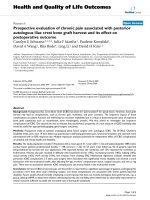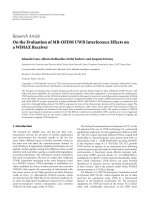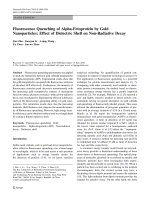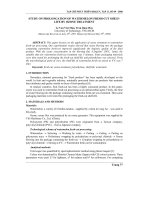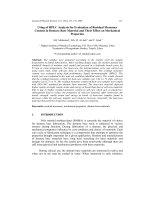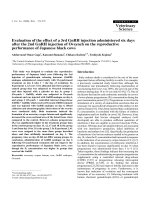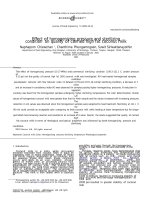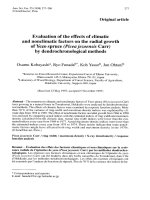Evaluation of antibacterial effect by ozone therapy on burn injury
Bạn đang xem bản rút gọn của tài liệu. Xem và tải ngay bản đầy đủ của tài liệu tại đây (163.1 KB, 6 trang )
Journal of military pharmaco-medicine 7-2013
EVALUATION OF ANTIBACTERIAL EFFECT BY OZONE THERAPY
ON BURN INJURY
Ho Anh Son*; Nguyen Linh Toan*; Vu Quoc Binh**
SUMMARY
Accidental and war trauma, burns and all sorts of acute and chronic cutaneous infections can be
proficiently treated with ozonated water. In current study, 24 burned rabbits were divided into 4 groups (6
rabbits in each group): topical treatment with saline; topical treatment with ozone; topical treatment with
ozone and ozone autohemotherapy (OAHT); and topical treatment with silvirin. The results showed that
topical use of ozone in burn wounds present in animal model allow a rapid antibacterial effectiveness
during the treatment periods.
* Key words: Bacteria; Ozone autohemotherapy; Burn; Rabbit.
INTRODUCTION
Human skin is the barrier to prevent entering of bacteria to the body, when the skin is
burned, these bacteria enter the wound and cause infection site. Bacteria can enter the burn
wounds from healthy skin around, waste of patients, from the care people, from linens, from
health care workers, and the atmosphere, drugs, the medical instruments… Many reports have
warned that burns hospital infections are a major cause of death in burn patients (accounting for
50 - 70%). The serious treated problem of drug-resistant bacteria present in the burn is also
mentioned. Besides, the cost of using systematic and tropical antibiotics accounts for a large
proportion of funding treatment. Therefore, we conducted this study using ozone as an
antimicrobial substance with strong effect has been known for a long treated history, with a very
low cost to assess their ability to antibacteria on the surface of burn wounds.
SUBJECTS AND METHOD
1. Study subjects.
Healthy Newzealand rabbits (from a farm in Hungyen province), medium weight 2
kg/each. Rabbits were breed in experimental conditions, individual clean cages during the study
period and free access to food, vegetable. Total number of rabbits was 24, including both male
and female, were randomized divided into 4 groups of 6 rabbits:
- NaCl group: animals were burned and the wounds were cleaned by saline solution.
- NaCl + O3 group: animals were burned and the wounds were cleaned by ozonated saline
solution.
- O3 + O3 group: animals were burned and the wounds were cleaned by saline solution and
OAHT.
- Silvirin group: animals were burned and the wounds were treated by Silvirin.
The experiment were performed in Pathophysiology Department, Vietnam Military
Medical University.
2. Method.
* Ozone autohemotherapy:
The method was descibed somewhere [1], in brief: 5 ml/kg body weigh ear vein blood
was collected in heparined plastic container with mixture of ozone-oxygen. The blood is exposed
to the gas mixture for 5 minutes and transfered back to the rabbit. The process of OAHT was
conducted in total of 6 times, 3 times per week, starting with 50 mcg/ml ozone dose and
increased to 50% after every 2 time of treatment [1, 2, 3].
1
Journal of military pharmaco-medicine 7-2013
Figure 1: Transfusion process of ozone exposure to rabbit vein blood.
* Experimental burn rabbit model:
Rabbits fur on back are removed, then they were mounted on the table. Animals were
anesthetised by thiophental, 50 mg/kg dose. A cyclindal container was poured by boiling water
and keep perpendicular to the back skin, followed by heavy weights 1 kg set up container for 30
seconds. The wound was done on both spine sides with grade III lesions, and covers about 10%
of the total surface area of rabbit skin.
* Ozonated saline to rinse the wounds:
Ozone dose of saline to wash the wound began 80 mcg/ml. After the first washed day,
the ozonated saline doses were reduced 10 mcg/ml per day. When the dose is reduced to 10
mcg/ml, this concentration is maintained until the wounds were heal.
* Assess the level of infection in burn wounds:
Microbiological tests in burns: rolling sterile swab on the surface burns injury, which is 1
cm2 area, is limited by the plastic paper. The test were performed before, after the of 3, 7 and 14
days of ozone treatment. The sterile cotton swab soaked in 0.9% NaCl sterile, push the swab
into a glass tube to reduce water, gently rolling on the wounds, roll across the gaps in the plastic,
so that the burn fluid stained on the entire circumference of the swab for 20 seconds. The swab
specimens were put into 5 ml tubes available 0.9% NaCl sterile. Shaking slightly the tube for
about 1 minute, transfer to lab microorganisms. Specimens were staging on the different cultures
agar, incubated at 370 C for 24 hours. Count the number of colonies on the agar culture, then
calculate the number of bacteria on the surface of 1 cm 2 burn wounds. The technique was
conducted on Bitex system in Paraclinical Department, National Institute of Burns.
* Data analysis:
Data was analyzes by Stata software and One way-ANOVA, SPSS 12.0.
RESULT
Table 1: The rate of infection in rabbits burns day 3 rd.
Group
(n = 12/group)
NaCl group (1)
Rate of infection (%)
b (-)
b < 103
103 < b < 104
104 < b < 105
b > 105
0
0
0
0
100
2
Journal of military pharmaco-medicine 7-2013
NaCl + O3 group (2)
33.3
0
0
0
66.7
O3 + O3 group (3)
33.3
0
0
0
66.7
Silvirin group (4)
0
0
0
0
100
p
> 0.05
(b: bacteria)
Results showed that the rate of microbial infections in burn wounds after 3 days of
treatment was quite common in the study groups. With two groups using ozonated saline to
clean wounds, rate of burns infection was 33.3%. Other burns in the remaining groups had over
105 bacteria/cm 2. Chi-square statical analysis showes no significant diference of rate infection
among agoups.
Table 2: The rate of infection in rabbits burns day 7 th.
Group
Rate of infection (%)
b (-)
b < 103
103 < b < 104
104 < b < 105
b > 105
NaCl group (1)
0
0
0
16.7
83.3
NaCl + O3 group (2)
0
0
0
16.7
83.3
O3 + O3 group (3)
16.7
0
0
50
33.3
Silvirin group (4)
0
0
50
0
50
p3-4
p3-1,2 < 0.05
< 0.005
p3,4 > 0.05
(n = 12/group)
> 0.05
p4-1,2,3 <
0.005
p
Data showed: infection rates increased significantly on day 7 after the process of burn
treatment. Only 2 burns (16.7%) in O 3 + O3 treated group, bacteria did not grow in the culture
dish. In the other burns, population of bacteria was over 103/cm 2.
In range 103 - 104/cm 2 bacterial infected burns, there were 6 (50%) of 12 wounds in
silvirin treated group, it is significanly lower than other groups (X2 = 8.0; p3-4 < 0.005).
The range 104 - 105/cm 2 bacterial infected burns, there were 6 (50%) of 12 wounds in
silvirin treated group, it is significanly lower than silvirin groups (X 2 = 8.0; p3-4 < 0.005).
A mong bacterial infected burns over 105/cm 2, there were four (33.3%) of 12 wounds in
O3 + O3 treated group, it is significanly lower than NaCl and NaCl+O 3 treated group (X2 = 6.17; p31,2 < 0.05).
Table 3: The rate of infection in rabbits burns day 14 th.
3
Journal of military pharmaco-medicine 7-2013
Group
rate of infection (%)
b (-)
b < 103
103 < b < 104
104 < b < 105
b > 105
0
0
0
16.7
83.3
NaCl + O3 group (2)
83.3
0
0
16.7
0
O3 + O3 group (3)
66.7
0
0
0
33.3
Silvirin group (4)
25
0
25
0
50
(n = 12/group)
NaCl group (1)
p2-1 < 0.001
p2-4 < 0.005
p3-1 < 0.005
p1-2<0.001
P1-3<0.05
p3-4 < 0.05
p4-2<0.005
p
Results showed advantages of using ozone therapy can reduced infected burns
significantly. Negative culture bacteria accounted for 66.7% in O 3 + O3 treated group and 83.3%
in NaCl + O3 treated group, it is significantly higher than NaCl and silvirin treated group (X2 =
17.1, p2-1 < 0.001; X2 = 8.22, p2-4 < 0.005; X2 = 12, p3-1 < 0.005; X2 = 4.2, p3-4 < 0.05).
Meanwhile, the NaCl and silvirin treated group were 100% and 75% burn-positive
bacterial culture, respectively (X2 = 17.1, p1-2 < 0.001; X2 = 6.17, p1-3 < 0.05; X2 = 8, p4-2 < 0.005).
Table 4: Speed of narrowing the wound size.
Wound size (cm 2)
Group
Day 3 rd
Day 7 th
Day 14 th
Day 21 th
Day 28 th
NaCl group (1)
15,1 0,86
10,8 0,77
6,6 0,36
2,93 0,18
1,24 0,45
NaCl + O3 group (2)
13,42 0,79
9,26 0,44
5,92 0,36
2,02 1,31
0,28 0,06
O3 + O3 group (3)
14,3 0,86
9,5 1,14
5,37 0,65
1,31 0,32
0,39 0,17
Silvirin group (4)
14,8 0,67
10,7 0,56
6 1,03
2,15 0,89
0,32 0,13
(n = 12/group)
p
> 0,05
p1 > 0,05
4
p1,3 < 0,05
p1,3 < 0,05
p1,2;1,3;1,4 <
0,05
Journal of military pharmaco-medicine 7-2013
The results showed that, in the first 7 days of treatment, there was no significant
difference of the burn area in the groups. The other treatments have not demonstrated a
significant improvement in speed of wound narrowing.
Figure 2: Speed of narrowing the wound size.
However, from day 14 th to day 21 th , the area of the O3 + O3 treated group has narrowed
significantly compared to NaCl treated group. By the end of the experiment on day 28 th, the
difference in size between the control group (NaCl) compared with othe groups treated with
ozone and silvirin was significantly larger (p < 0.05).
DISCUSSION
Ozone increases the immune response and the role of anti-free radical system when the
body suffers serious stress. It could preventing, reducing, normalized the chronic oxidative stress
and enhanced release of bone marrow stem cells. In addition, ozone is applied for the treatment
of local infections, chronical ulcers. Disinfection probability of ozone is based on the chemical
structure of three oxygen atoms. Ozone is strong oxidants, capable of destroying most of the
organic compounds, ozone is also capable of killing fungal spores and bacteria. Therefore,
ozone is often used as an antiseptic and has the strongest effect. In burn wounds, 80 mcg/ml
ozonated saline in the early days had strongly antiseptic effect and rinse the necrosis tissue
(Bocci, 2005) [3]. The next days, lower concentration of ozone was still able to kill bacteria but
are harmless to tissue in the wound healing process.
Local treatment with ozonated saline and/or in combination with OAHT could strongly
effect on reducing the burns infections (Giunta et al, 2001; Zamora et al, 2005) [5]. The
advantage is not only comparable with normal saline treated group, but also with silvirin treated
group. By observation, we found the burns surface treated by ozonated saline, dryer and cleaner
than other treated groups. Thus, besides the probability to kill bacteria, ozone has a cleansing
effect, dry surface and promote the burn healing (De Souza et al, 2010) [4]. By that way, ozone is
directly or indirectly reducing the amount of bacteria in surface burns injury.
CONCLUSION
This study evaluated the bacterial resistant effectiveness of ozone, were performed on 24
burned rabbits, which were burned with the same area and depth. Rabbits were divided into 4
groups, including group of saline treatment, ozonated saline, OAHT and topical creams silvirin.
The results indicated that ozone therapy is a promising treatment method in burn injury, it could
significantly reduces burn wound infections and promotes wound healing.
REFERENCES
5
Journal of military pharmaco-medicine 7-2013
1. Vu Quoc Binh, Ho Anh Son, Nguyen Linh Toan. No effect of ozonenate autohemotherapy on
plasma SOD activity, glucose, acid uric, IL-1α, TNF-α and IL-10 levels in healthy rabbits. Journal of 108clinical Medicine and Pharmacy. 2011, 3 (6), pp.24-29.
2. Bocci B, Valacchi G, Corradeschi F, Fanetti G. Studies on the biological effects of ozone:
Effects on the total antioxidant status and on interleukin-8 production. Med Infl. 1998, 7, pp.313-317.
3. Bocci V. Ozone - a new medical drug. Springer. 2005.
4. De Souza Y.M, Fontes B, Martins J.O, Sannomiya P, Brito G.S, Younes R.N, Rasslan S.
Evaluation of the effects of ozone therapy in the treatment of intra-abdominal infection in rats. Clinics. 2010,
65, pp.195-202.
5. Giunta R, Coppola A, Luongo C, Sammartino A, Guastafierro S, Grassia A, Giunta L, Mascolo
L, Tirelli A, Coppola A. Ozonized autohemotransfusion improves hemorheological parameters and oxygen
delivery to tissues in patients with peripheral occlusive arterial disease. Ann Hematol. 2001, 80, pp.745748.
6. Zamora ZB, Borrego A, López OY, Delgado R, González R, Menéndez S, Hernández F, Schulz
S. Effects of ozone oxidative preconditioning on TNF-alpha release and antioxidant-prooxidant intracellular
balance in mice during endotoxic shock. Mediators Inflamm. 2005, 24, pp.16-22.
6

